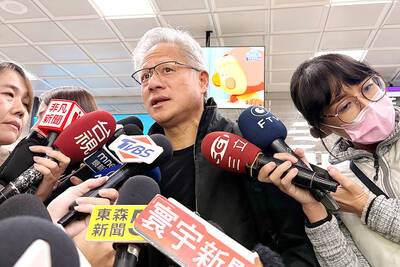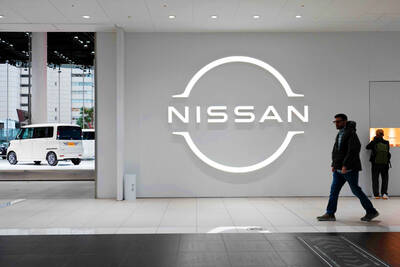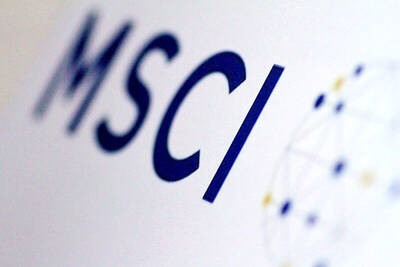Intel Corp has agreed to acquire Tower Semiconductor Ltd for about US$5.4 billion, part of chief executive officer Pat Gelsinger’s push into the outsourced chip manufacturing business.
Intel is to pay US$53 per share in cash for Tower, it said in a statement on Tuesday.
The offer represents a 60 percent premium to Tower’s closing share price in US trading on Monday. The companies’ boards have approved the transaction, which they expect to close in about 12 months.
Gelsinger, who took the job a year ago, is betting he can compete with Taiwan Semiconductor Manufacturing Co (TSMC, 台積電) in the chip foundry market — the contract manufacturing of semiconductors for other companies.
His comeback plan for Intel involves modernizing its factories and building new ones aimed at restoring its leadership in chip technology.
With Tower, Intel is acquiring customers and expertise. The chip foundry industry requires experience in handling different types of chips and designs. Intel has previously had little success in that area because of a lack of commitment to it, Gelsinger has said.
Intel’s factories have historically produced only its own designs.
Tower makes power management chips, image sensors and a variety of other semiconductors. Its customers include Analog Devices Inc and Broadcom Inc, data compiled by Bloomberg showed.
What the move does not provide is scale. Tower had annual sales of about US$1.3 billion last year, a fraction of TSMC’s US$56 billion.
KeyBanc Capital Markets analysts called the deal “moderately positive” for Intel.
As TSMC is a specialty foundry, it is unclear whether the acquisition would help Intel expand to the same volumes and compete with Samsung Electronics Co and TSMC on mainstream process technologies.
TSMC’s sales are expected to grow about 27 percent this year, data compiled by Bloomberg showed.
The Hsinchu-based company, which pioneered the market, accounts for more than 50 percent of industry revenue and makes chips for many of Intel’s key rivals, a list that includes Advanced Micro Devices Inc and Nvidia Corp.
Tower, which is based in northern Israel, was formed from the combination of other companies’ plants, starting in the 1990s. It also owns a factory in Texas.
It is similar to, but much smaller than GlobalFoundries Inc, a US-based chip manufacturer that Intel considered making a bid for last year. A deal never materialized and GlobalFoundries’ owner, Mubadala Investment Co, proceeded with an initial public offering of the company in October last year.
On a conference call with analysts to discuss the deal, Gelsinger said that Tower complemented Intel’s military contracts.
Intel also plans to build on Tower’s partnership with STMicroelectronics NV, Gelsinger said.
The Tower deal is just part of Gelsinger’s plan to get Intel back on track. He is also building a factory in Ohio that could cost US$20 billion and new facilities in Europe. The spending spree is weighing on Intel’s profit margins and has put investors on edge.
The company’s earnings missed analysts’ projections last quarter, and it gave a disappointing outlook, but Intel has said that profit margins could be back to historically high levels within five years.
Gelsinger also is seeking government funding to rebuild manufacturing in the US and Europe, saying that too much of the industry’s production has shifted to Asia.

PERSISTENT RUMORS: Nvidia’s CEO said the firm is not in talks to sell AI chips to China, but he would welcome a change in US policy barring the activity Nvidia Corp CEO Jensen Huang (黃仁勳) said his company is not in discussions to sell its Blackwell artificial intelligence (AI) chips to Chinese firms, waving off speculation it is trying to engineer a return to the world’s largest semiconductor market. Huang, who arrived in Taiwan yesterday ahead of meetings with longtime partner Taiwan Semiconductor Manufacturing Co (TSMC, 台積電), took the opportunity to clarify recent comments about the US-China AI race. The Nvidia head caused a stir in an interview this week with the Financial Times, in which he was quoted as saying “China will win” the AI race. Huang yesterday said

Nissan Motor Co has agreed to sell its global headquarters in Yokohama for ¥97 billion (US$630 million) to a group sponsored by Taiwanese autoparts maker Minth Group (敏實集團), as the struggling automaker seeks to shore up its financial position. The acquisition is led by a special purchase company managed by KJR Management Ltd, a Japanese real-estate unit of private equity giant KKR & Co, people familiar with the matter said. KJR said it would act as asset manager together with Mizuho Real Estate Management Co. Nissan is undergoing a broad cost-cutting campaign by eliminating jobs and shuttering plants as it grapples

The Chinese government has issued guidance requiring new data center projects that have received any state funds to only use domestically made artificial intelligence (AI) chips, two sources familiar with the matter told Reuters. In recent weeks, Chinese regulatory authorities have ordered such data centers that are less than 30 percent complete to remove all installed foreign chips, or cancel plans to purchase them, while projects in a more advanced stage would be decided on a case-by-case basis, the sources said. The move could represent one of China’s most aggressive steps yet to eliminate foreign technology from its critical infrastructure amid a

MORE WEIGHT: The national weighting was raised in one index while holding steady in two others, while several companies rose or fell in prominence MSCI Inc, a global index provider, has raised Taiwan’s weighting in one of its major indices and left the country’s weighting unchanged in two other indices after a regular index review. In a statement released on Thursday, MSCI said it has upgraded Taiwan’s weighting in the MSCI All-Country World Index by 0.02 percentage points to 2.25 percent, while maintaining the weighting in the MSCI Emerging Markets Index, the most closely watched by foreign institutional investors, at 20.46 percent. Additionally, the index provider has left Taiwan’s weighting in the MSCI All-Country Asia ex-Japan Index unchanged at 23.15 percent. The latest index adjustments are to